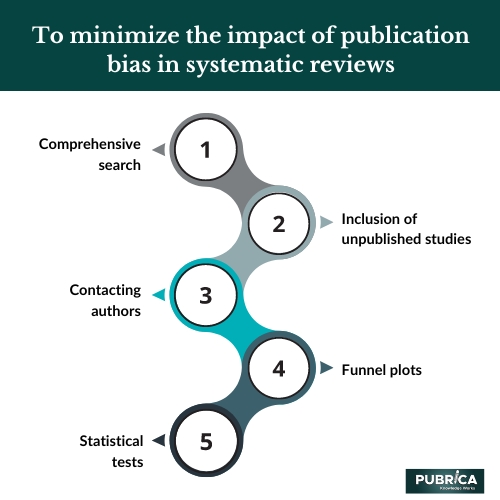What Is Publication Bias In A Systematic Review?
What Is Publication Bias In A Systematic Review?
Publication bias is one threat to delivering an unbiased effect estimate. Publication bias is a phenomenon in which journals are more inclined to publish favourable outcomes because these papers receive more citations. Non-significant publications are more likely to be rejected and remain unpublished. 'Grey literature' refers to unpublished resources.
Best deal with publication bias:
Controlling publication bias is critical, given that it is doubtful that publication bias will ever be completely resolved. Controlling for publication bias may be accomplished in many ways:
- trials must be registered before the study beginning,
- funnel plots can be used to assess the existence of publication bias visually, and numerous grey literature sources must be searched using a sensitive search technique. Clinical studies must be registered in trial registers in most countries.
Furthermore, research is frequently presented at conferences prior to publication, allowing them to be discovered.
Publication bias is a type of bias that can occur in systematic reviews and other forms of literature reviews. It arises when the published research literature does not represent all studies conducted on a particular topic, especially when studies with a systematic review of qualitative or quantitative or positive results are more likely to be published than those with non-significant or negative results.

Reasons:
Publication bias occurs for various reasons, including the preference of journals to publish studies with novel, positive, or statistically significant findings while rejecting studies with null or non-significant results. Researchers themselves may also be less likely to submit or publish studies that do not yield statistically significant or exciting outcomes, which can further contribute to publication bias[1].
Implications:
The implications of publication bias in systematic reviews can be significant. When only studies with positive results are included in the review, it can lead to an overestimation of the effectiveness or impact of a particular intervention or treatment. Conversely, if studies with negative results are omitted, the review may underestimate an intervention's potential harms or side effects.
To minimize the impact of publication bias in systematic reviews, researchers can employ several strategies:
- Comprehensive search: Conduct an exhaustive meta-analysis and systematic search of multiple sources, including unpublished studies, conference abstracts, and grey literature.
- Inclusion of unpublished studies: Consider including studies that have not been formally published, such as doctoral theses or research reports.
- Contacting authors: Reach out to authors of included studies to inquire about any unpublished or ongoing research relevant to the narrative review.
- Funnel plots: Use funnel plots to visualize potential publication bias. Funnel plots plot the effect size or study outcome against study precision (typically represented by the sample size or standard error). Asymmetry in the funnel plot may suggest publication bias.
- Statistical tests: If appropriate, conduct statistical tests for publication bias, such as Egger's regression test or Begg's rank correlation test.
By employing these strategies and acknowledging the potential limitations of publication bias, systematic review authors can enhance the reliability and validity of their findings and conclusions.
Give yourself the Medical edge today
Each order includes
- On-time delivery or your money back
- A fully qualified writer in your subject
- In-depth proofreading by our Quality Control Team
- 100% confidentiality, the work is never re-sold or published
- Standard 7-day amendment period
- A paper written to the standard ordered
- A detailed plagiarism report
- A comprehensive quality report

